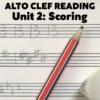100 ALTO CLEF SIGHT-SINGING DRILLS
By this point in my Alto Clef Reading Course, you should have sharpened your recognition of alto clef pitches by using my provided flashcards; developed your own reliable, natural freehand alto clef writing, along with practicing the reversed positions of key signatures; and most importantly of all, studied the repertoire and scoring of those instruments and singers using alto clef. Now you’re ready for some additional training, which will make your understanding of alto clef pitches so innate that there won’t be the slightest hesitation in processing the reading (or playing) of any note you see.
The next logical step is a bit of solfège – applying principles of sight-singing to alto clef just as you may already have done with bass and treble clef. So in the attachment below, I’ve prepared a short PDF volume of 100 drills for you to use. The only preliminary requirement here is for you to have done at least some basic sight-singing of your own. If you haven’t yet, hold everything and go study some other ground-level materials, such as Ronald and Holly Shaw-Slabbinck’s One-Minute Sight Singing, Books 1 and 2. (Patreon supporters from the Breve level up may want to sharpen their skills using the Sight-Singing Catch-up materials from my Audition 101 course). Once you’ve caught up (or perhaps just reviewed if it’s been a while), and you feel capable with the fundamentals, then you’re ready to take on my alto clef drills.
PROCEDURES
You want to practice your sight-singing in a quiet place without distractions (especially noise or other music). Have a musical instrument on hand to give you the starting pitch if you need it. Sit or stand in a relaxed but upright position, back straight, and abdomen well-supported for singing. Tap your chest, knee, or some other surface with your hand in order to keep time, or tap your foot if that feels more natural. Don’t bother repeating any exercise in order to fix it, just move on to the next one – unless you feel like you’re completely out of your depth. Don’t worry about the sound of your voice. These exercises will take your range very high or low, depending on your voice type – and it’s perfectly natural for lower voices to sing the pitches an octave down (or an octave up for higher voices on some low pitches). Just do your best to keep up a steady pace, with as accurate a pitch as you can get (it’s perfectly fine to check your pitch from time to time with your instrument, but don’t turn it into a crutch). Give each note and rest its full rhythmic value, and slow down as necessary when you get to drills with 8th notes and 16th notes.
CONTENT
Usually a sight-singing course adds certain elements of rhythmic and harmonic complexity with each new unit. I have kept these to a minimum, as my goal here is a full immersion in recognising and singing back the pitches of the alto staff with greater facility. Probably the student will find the going more tough towards the end as the pitches rise very high above the staff. But these are precisely the notes in the most need of effortless recognition when score-reading, especially a page of full orchestra.
My volume is divided into 5 units is 20 drills each. Unit 1 starts with sight-singing over the natural pitches (C major) of the alto staff. The keynote of C being centrally located, this moves the melodic arcs above and below the tonic, rather than running up and down over a complete scale at first. Unit 2 follows with reading over the two C major scales located on either side of the middle point of the alto clef, adding a few notes higher and lower than the staff in order to cover 15 sequential pitches from C3 to C5. Units 3 & 4 show how the landscape of G Major and F major lie across the general scope of the alto staff; and allows for the approach of moveable or fixed do, depending on the preference of the student. Unit 5 wraps up the study with an exploration of the highest pitches above the staff, and offers drills in all three keys hence explored, plus their relative minors of A, E, and D.
My advice is to take this at a methodical pace. Try one unit a day, or even just one page per day. As mentioned before, don’t try to fix anything, just move on to the next drill. Once you’ve completed the whole volume, then wait a few days before revisiting the material. You’ll probably find that the first two units feel much easier, the next two a bit better, but the final unit still challenging. That’s perfectly normal. Three times through is probably enough, but as many as five run-throughs are fine, and will strengthen your reading – and scoring – with powerful insight.
There’s one more crucial step to this course: melodic dictation. I’ll share that final step in a few days, hang on.









